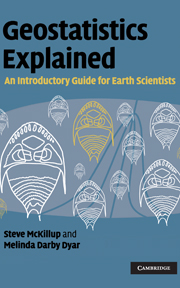
-
Select format
-
- Publisher:
- Cambridge University Press
- Publication date:
- 05 June 2012
- 25 March 2010
- ISBN:
- 9780511807558
- 9780521763226
- 9780521746564
- Dimensions:
- (228 x 152 mm)
- Weight & Pages:
- 0.78kg, 414 Pages
- Dimensions:
- (228 x 152 mm)
- Weight & Pages:
- 0.55kg, 414 Pages
You may already have access via personal or institutional login
Book description
A reader-friendly introduction to geostatistics for students and researchers struggling with statistics. Using simple, clear explanations for introductory and advanced material, it demystifies complex concepts and makes formulas and statistical tests easy to apply. Beginning with a critical evaluation of experimental and sampling design, the book moves on to explain essential concepts of probability, statistical significance and type 1 and type 2 error. An accessible graphical explanation of analysis of variance (ANOVA) leads onto advanced ANOVA designs, correlation and regression, and non-parametric tests including chi-square. Finally, it introduces the essentials of multivariate techniques, multi-dimensional scaling and cluster analysis, analysis of sequences and concepts of spatial analysis. Illustrated with wide-ranging examples from topics across the Earth and environmental sciences, Geostatistics Explained can be used for undergraduate courses or for self-study and reference. Worked examples at the end of each chapter reinforce a clear understanding of the statistical tests and their applications.
Reviews
'I can highly recommend this book based on my own experience with it, and can also imagine it being very useful for those teaching statistical methods to geoscientists.'
Nina Kirchner - Stockholm University
'… provides a lifeline for students and researchers across the Earth and environmental sciences who until now have struggled with statistics … demystifies complex concepts and makes formulas and statistical tests easy to understand and apply.'
Source: The Eggs
'… reading this book will stop students, researchers and working geologists from using statistics packages as ‘black boxes’. There’s now no excuse for not having a basic grasp of what you’re doing, why you’re doing it and how to interpret (but not over-interpret) the results.'
Source: Geological Magazine
Contents
Metrics
Altmetric attention score
Full text views
Full text views help Loading metrics...
Loading metrics...
* Views captured on Cambridge Core between #date#. This data will be updated every 24 hours.
Usage data cannot currently be displayed.
Accessibility standard: Unknown
Why this information is here
This section outlines the accessibility features of this content - including support for screen readers, full keyboard navigation and high-contrast display options. This may not be relevant for you.
Accessibility Information
Accessibility compliance for the PDF of this book is currently unknown and may be updated in the future.


